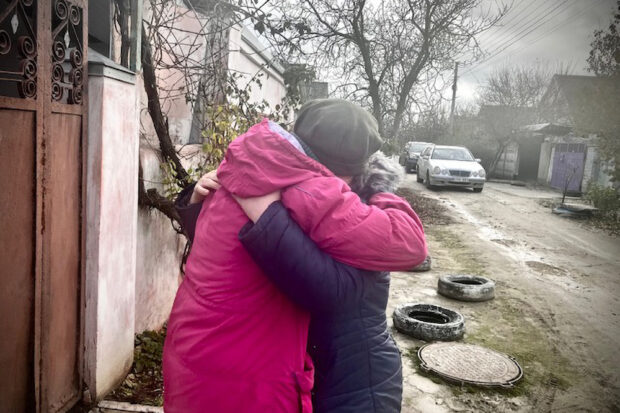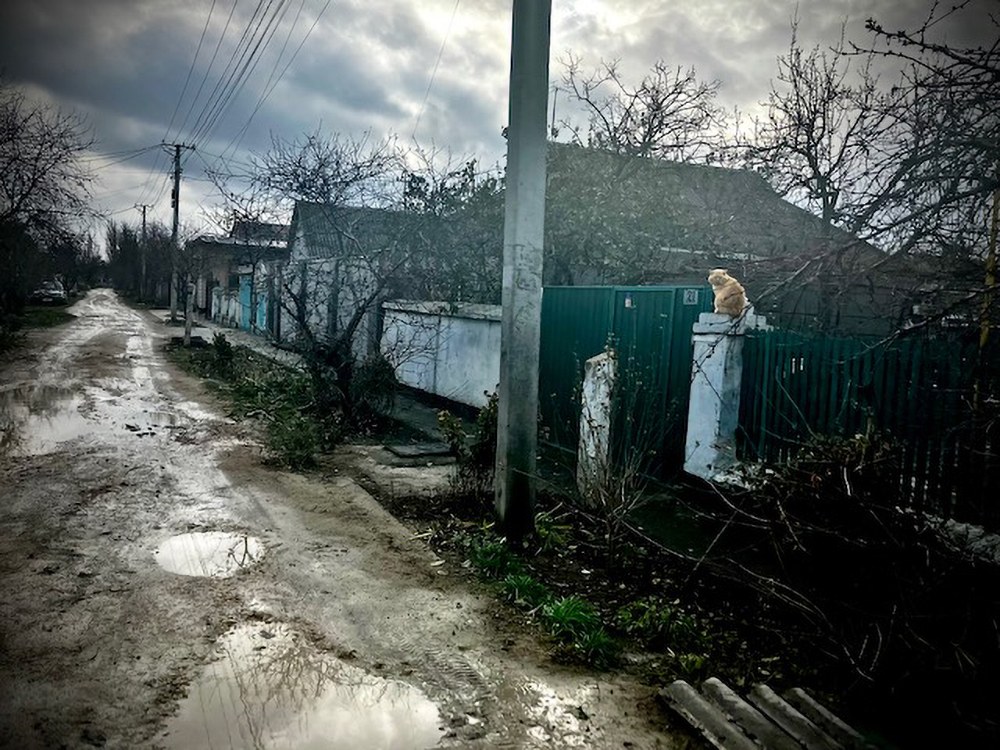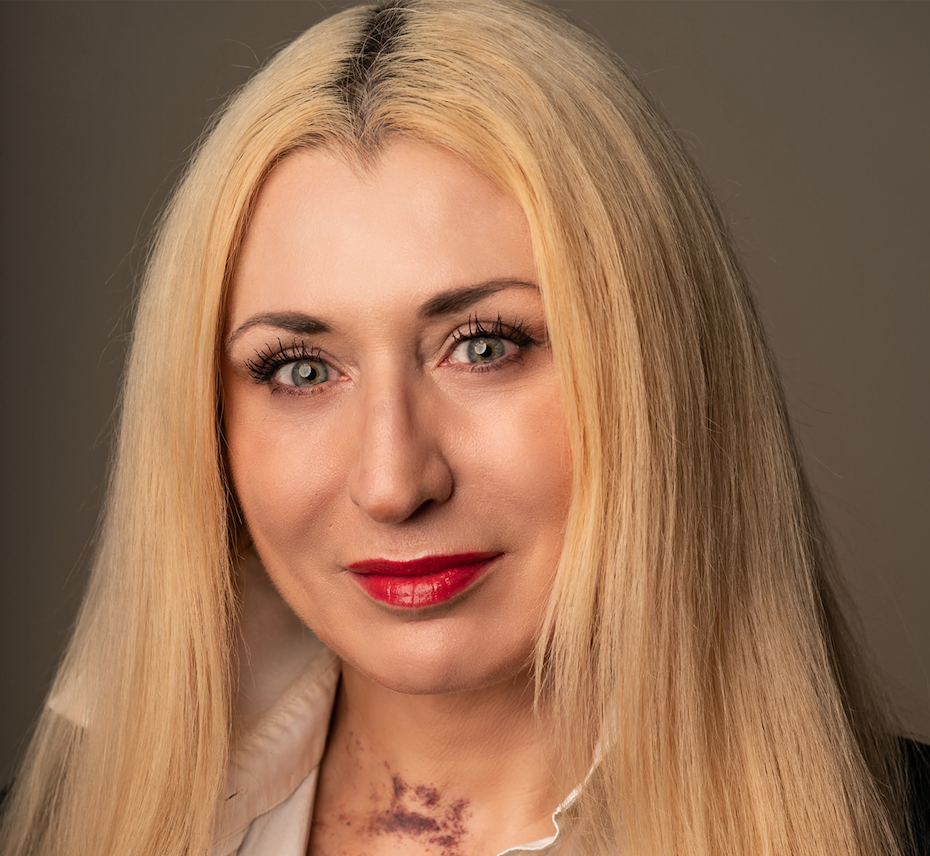
Poselok Tekstilshchikov, literally translated as Textile Workers Village, appeared in the 1960s in the Soviet Union. Almost 20,000 people, mostly women, worked at the Kherson Cotton Mill. The mill closed in 2013, but the suburb, labeled a “settlement of urban type,” is still a home to the veterans of the mill and their families. Located only a 10-minute drive from downtown Kherson in southern Ukraine, the place presents a challenging reality during the Russian full-scale invasion of Ukraine.
On a cold November day in 2023, we visited the village, struggling to move along the unpaved roads. In a spacious house, 87-year-old Leonid battled dementia that set in after the onset of war. Leonid’s monthly pension is $190. According to his daughter—his sole caregiver—this is quite a handsome sum. She described managing his daily falls and self-inflicted injuries.
Lost in his world, Leonid often conducts an imaginary work meeting and gives orders. He worked for 50 years at the mill and loved his job.
“The dementia only started when the Russian Federation started the invasion,” said his daughter. “Because of the daily shelling and logistics difficulties, I cannot take my father to the doctors and try to manage everything myself.”
Across the street, Lida, 88, bedridden for four years, relies on a $162 pension to survive. Her monthly needs, totaling $540 for medication and care, far exceed her income. Yet, Lida is lucky: Her family did not flee the war zone and works hard to provide for her.
Nina, in her late 70s, faces the struggle for survival on her own. She is still grieving the loss of her only son in the summer of 2022. The Russian occupational forces arrested, tortured and killed him, but his military records were destroyed during the fire at the office during the Russian retreat. Nina faces challenges in receiving his pension. Her gas and power bills are unpaid, and she is left without heat and ways to cook food in the winter.
Next door, Luda, a shy woman in her late 50s, also grapples with unpaid bills and loss of power for more than a year, as she cares for her severely handicapped daughter Victoria, 20.]

Another Nina, a retired librarian and war veteran, risked her safety to shelter injured Ukrainian soldiers in her home during the Russian occupation. One of them died, and she had to secretly transport his body out in a blanket. Nina loves to show her book collection and offers tea, coffee and cookies. Later, Luba, a woman who introduced us, explained that Nina has a small pension but never asks for help or money from her family.
Like many Khersonians, the residents of Poselok Tekstilshchikov are fiercely independent. Grisha, in his late 80s, battles solitude and physical limitations: He has one eye and walks on crutches. Living alone after his family moved away, he reluctantly accepts his neighbors’ food and care but has refused any assistance from the volunteers.
Raya, aged 88, almost deaf and blind, lives in a hut with her Down syndrome granddaughter Yana. She raised two granddaughters herself, selling milk from two cows and produce from her vegetable garden at a market. Her older son died, and the younger one tried to make money working abroad but got detained in Russia. Raya also declined help.
“We are doing all right,” said Raya. “I just want the war to end so my children and grandchildren can come back.”
Luba shoulders the responsibility of caring for her neighbors while grappling with her own health challenges and issues. She has three young kids attending an online school, a father dying from cancer and a bedridden mother.
Luba suffered six micro-strokes. In her yard, she has a giant Caucasian shepherd she saved during the flood caused by the Russian explosion at the Nova Kakhovka dam. Still, Luba runs a fundraiser to bring Christmas gifts to 188 children still living in the village.
Despite the recommendations to evacuate, many families choose to stay for various reasons. Mostly, it is the lack of funds and bedridden or handicapped relatives.
“I cannot leave,” said Luba. “These people rely on me to survive. We have 33 bedridden folks. Only yesterday, a woman had gangrene and later died during the surgery.”
Volunteers such as Luba have a hard time helping the community. In Kherson City, on Dec. 5, National Volunteer Day, the Russian Federation targeted, damaged and destroyed two volunteer centers and humanitarian hubs, killing two civilians, including one volunteer, and injuring four health workers, a man returning home from a market and a young woman walking a dog.

Another volunteer, Olha, helps the elderly with humanitarian aid and errands while running a grocery store in Kherson. Her store has been hit and damaged five times, after being flooded after the dam explosion.
Volodymyr, a volunteer fearlessly delivering food, hygiene products and medications to the neighborhoods close to the Dnipro River, often doesn’t have wheels as his car breaks or the tires are punctured from driving on shrapnel and cluster munition. His house is under fire every day and every night and was hit several times. Volodymyr finds a way to deliver help even if he has to walk across town under fire.
In mid-December, these and other volunteers managed to get toys and sweets for 188 children of Poselok Tekstilshchikov and deliver them, under fire.
The attacks on the Kherson Region intensified. According to the Kherson Regional Military Administration reports and the Head of the City Military Administration for Kherson City public reports, from Dec. 1 to 11, 2023, Russian troops initiated 836 attacks on the Kherson Region, with daily attacks ranging from 69 to 264, averaging 86 attacks per day.
The total number of shells employed in these attacks was 4,834, including ordnance from mortars, artillery, “Grads,” tanks, drones and aviation. Three missiles hit the residential areas.
On Dec. 12 only, Russians launched 113 attacks and used 606 shells. The exact number of guided aerial bombs over the entire period is not available, but on Dec. 2, Russian troops dropped 43 guided aerial bombs on the villages of the left and right banks of the Dnipro River in the Kherson Region. Casualties included nine civilians killed and 48 injured for 11 days. Kherson City was targeted with 3,227 shells during this period, with a daily range from 32 to 145, averaging 84 daily attacks.

